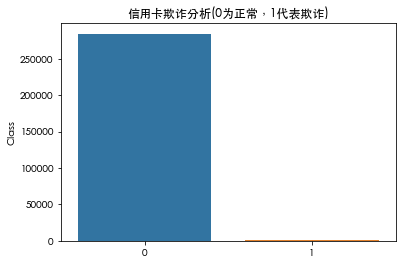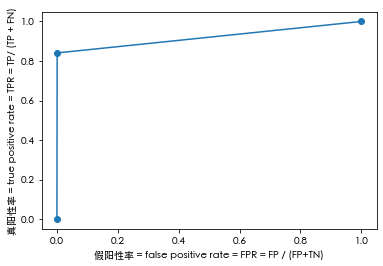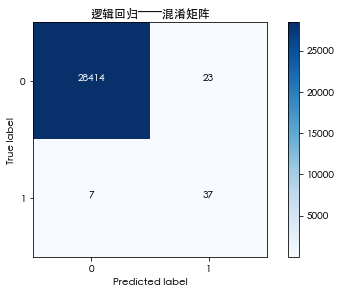获取数据
数据集包括了 2013 年 9 月份两天时间内的信用卡交易数据,284807 笔交易中,一共有 492 笔是欺诈行为。输入数据一共包括了 28 个特征 V1,V2,……V28 对应的取值,以及交易时间 Time 和交易金额 Amount。为了保护数据隐私,我们不知道 V1 到 V28 这些特征代表的具体含义,只知道这 28 个特征值是通过 PCA 变换得到的结果。另外字段 Class 代表该笔交易的分类,Class=0 为正常(非欺诈),Class=1 代表欺诈。针对这个数据集构建一个信用卡欺诈分析的分类器,并计算F1。
import pandas as pdimport numpy as npfrom sklearn.linear_model import LogisticRegressionfrom sklearn.model_selection import train_test_splitfrom sklearn.preprocessing import StandardScalerfrom sklearn.metrics import recall_score,roc_curve,confusion_matrix#召回率,精准率,混合矩阵import warningswarnings.filterwarnings('ignore')import matplotlib.pyplot as pltimport seaborn as snsplt.rcParams['font.sans-serif']=['Heiti TC']# 显示中文字体
data=pd.read_csv('creditcard.csv')
数据探索
data.head()
5 rows × 31 columns
data.info()
<class 'pandas.core.frame.DataFrame'>RangeIndex: 284807 entries, 0 to 284806Data columns (total 31 columns):Time 284807 non-null float64V1 284807 non-null float64V2 284807 non-null float64V3 284807 non-null float64V4 284807 non-null float64V5 284807 non-null float64V6 284807 non-null float64V7 284807 non-null float64V8 284807 non-null float64V9 284807 non-null float64V10 284807 non-null float64V11 284807 non-null float64V12 284807 non-null float64V13 284807 non-null float64V14 284807 non-null float64V15 284807 non-null float64V16 284807 non-null float64V17 284807 non-null float64V18 284807 non-null float64V19 284807 non-null float64V20 284807 non-null float64V21 284807 non-null float64V22 284807 non-null float64V23 284807 non-null float64V24 284807 non-null float64V25 284807 non-null float64V26 284807 non-null float64V27 284807 non-null float64V28 284807 non-null float64Amount 284807 non-null float64Class 284807 non-null int64dtypes: float64(30), int64(1)memory usage: 67.4 MB
data.describe()
8 rows × 31 columns
# 欺诈和正常交易可视化f, (ax1, ax2) = plt.subplots(2, 1, sharex=True, figsize=(15,8))bins = 50ax1.hist(data.Time[data.Class == 1], bins = bins, color = 'deeppink')ax1.set_title('诈骗交易')ax2.hist(data.Time[data.Class == 0], bins = bins, color = 'deepskyblue')ax2.set_title('正常交易')plt.xlabel('时间')plt.ylabel('交易次数')plt.show()

清洗数据
数据较为干净未发现缺失值
单变量分析
count=pd.DataFrame(data['Class'].value_counts())sns.barplot(x=count.index,y=count['Class'])plt.title('信用卡欺诈分析(0为正常,1代表欺诈)')plt.show()

特征选取
data.corr()['Class'].sort_values()
V17 -0.326481V14 -0.302544V12 -0.260593V10 -0.216883V16 -0.196539V3 -0.192961V7 -0.187257V18 -0.111485V1 -0.101347V9 -0.097733V5 -0.094974V6 -0.043643Time -0.012323V24 -0.007221V13 -0.004570V15 -0.004223V23 -0.002685V22 0.000805V25 0.003308V26 0.004455Amount 0.005632V28 0.009536V27 0.017580V8 0.019875V20 0.020090V19 0.034783V21 0.040413V2 0.091289V4 0.133447V11 0.154876Class 1.000000Name: Class, dtype: float64
def remove_collinear_features(x, threshold):
'''
Objective:
删除数据帧中相关系数大于阈值的共线特征。 删除共线特征可以帮助模型泛化并提高模型的可解释性。
Inputs:
阈值:删除任何相关性大于此值的特征
Output:
仅包含非高共线特征的数据帧
'''
y = x['Class']
x = x.drop(columns = ['Class'])
# 计算相关性矩阵
corr_matrix = x.corr()
iters = range(len(corr_matrix.columns) - 1)
drop_cols = []
# 迭代相关性矩阵并比较相关性
for i in iters:
for j in range(i):
item = corr_matrix.iloc[j:(j+1), (i+1):(i+2)]
col = item.columns
row = item.index
val = abs(item.values)
# 如果相关性超过阈值
if val >= threshold:
# 打印有相关性的特征和相关值
# print(col.values[0], "|", row.values[0], "|", round(val[0][0], 2))
drop_cols.append(col.values[0])
# 删除每对相关列中的一个
drops = set(drop_cols)
# 将得分添加回数据
x['Class'] = y
return x
# 删除相关性大于0.6的特征向量
features = remove_collinear_features(data, 0.6)
发现变量之前不存在互相影响的情况,针对V1-28进行研究
# 对金额进行标准化处理
data['Amount_Norm']=StandardScaler().fit_transform(data['Amount'].values.reshape(-1,1))
结果显示数据之间不存在共线性问题
构建模型
data['Amount_Norm'] = StandardScaler().fit_transform(data['Amount'].values.reshape(-1,1))
# 特征选择
y = np.array(data.Class.tolist())
data = data.drop(['Time','Amount','Class'],axis=1)
X = np.array(data.as_matrix())
# 准备训练集和测试集
train_x, test_x, train_y, test_y = train_test_split (X, y, test_size = 0.1, random_state = 33)
# 逻辑回归分类
clf = LogisticRegression()
clf.fit(train_x, train_y)
predict_y = clf.predict(test_x)
recall_score,roc_curve,confusion_matrix
#计算召回率
R=recall_score(predict_y,test_y)
print('召回率R='+str(R))
召回率R=0.8409090909090909
fpr, tpr, thresholds=roc_curve(predict_y,test_y)
plt.plot(fpr,tpr,marker = 'o')
plt.ylabel('真阳性率 = true positive rate = TPR = TP/ (TP + FN)')
plt.xlabel("假阳性率 = false positive rate = FPR = FP / (FP+TN)")
plt.show()

from sklearn.metrics import auc
AUC = auc(fpr, tpr)
print('AUC='+str(AUC))
AUC=0.9200501427397725
cm=confusion_matrix(predict_y,test_y,labels=[0,1])
import itertools
classes= [0,1]
cmap = plt.cm.Blues
plt.figure()
plt.imshow(cm, interpolation = 'nearest', cmap = cmap)
plt.title('逻辑回归——混淆矩阵')
plt.colorbar()
tick_marks = np.arange(len(classes))
plt.xticks(tick_marks, classes, rotation = 0)
plt.yticks(tick_marks, classes)
thresh = cm.max() / 2.
for i, j in itertools.product(range(cm.shape[0]), range(cm.shape[1])) :
plt.text(j, i, cm[i, j],
horizontalalignment = 'center',
color = 'white' if cm[i, j] > thresh else 'black')
plt.tight_layout()
plt.ylabel('True label')
plt.xlabel('Predicted label')
plt.show()


